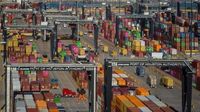As the global automotive industry braces for significant changes, the United States is set to reintroduce a 25% tariff on imported cars, a move that has sparked concerns and debates across the sector. This decision, revived during the second term of the Trump administration, aims to bolster domestic production and reduce the trade deficit, but analysts warn that the price increase due to the tariff could reach as much as $12,000 per vehicle.
In April 2025, nearly half of the cars sold in the U.S. are imports, making this tariff a critical factor in reshaping price competitiveness among manufacturers. Companies with a higher proportion of local production in the U.S. are expected to fare better, while those heavily reliant on imports may face significant challenges. The shift in purchasing trends among U.S. consumers, who have previously favored SUVs, towards hybrid and electric vehicles is also anticipated as a result of the tariff.
Following the tariff announcement, the automotive industry has experienced a stark divide. U.S.-based manufacturers, such as Ford and General Motors, have less exposure to the tariff due to their domestic production bases. In contrast, foreign manufacturers relying on overseas factories to supply vehicles to the U.S. market are bracing for a potential loss in price competitiveness. Approximately 8 million of the 16 million new cars purchased by U.S. consumers are imports, particularly from major exporting countries like Germany, Japan, and South Korea.
Stock market reactions have mirrored these concerns; electric vehicle manufacturers like Tesla, which rely entirely on U.S. production, saw their stock prices rise, while traditional automakers like GM and Ford experienced declines of 4-7%. This reflects fears of an overall contraction in car demand, indicating that the risk of a shrinking market due to tariffs is not to be overlooked. However, the price competitiveness of U.S.-made vehicles has undeniably increased.
A recent report highlighted the local production ratios of major brands, indicating that companies with higher domestic production ratios will face less pressure from tariff-induced price increases. For instance, Ford relies on imports for only 21% of its U.S. sales, while GM and Stellantis have import ratios around 45%. Tariffs primarily affect models imported from factories in Mexico or Canada, with partial exemptions possible based on the ratio of U.S.-made parts.
In response to the tariff, the Big Three automakers have initiated aggressive marketing strategies to minimize consumer confusion and maintain market share. Ford and Stellantis have offered employee discounts to general customers on most models, aiming to absorb the price increases due to tariffs and prevent demand erosion. Sales surged in March before the tariff implementation, with Ford's sales increasing by 10% year-over-year and GM's first-quarter sales rising by 17%, as consumers rushed to buy vehicles before prices went up.
Tesla is poised to be the biggest beneficiary of the tariff, as all its cars sold in the U.S. are produced domestically, and it sources key components like batteries through North American supply chains. This positions Tesla advantageously, especially as competing imported electric vehicles face price increases due to the tariff.
Japanese manufacturers, including Toyota and Honda, have invested heavily in local production, which has partially mitigated the impact of the tariffs. For example, Honda produces 65% of its U.S. sales volume in local factories, and Toyota produces about half of its volume domestically. However, some popular models still rely on imports, leaving them vulnerable to tariff impacts.
Hyundai and Kia, South Korean brands, face significant challenges due to their lower local production ratios of around 30-40%. With over half of their sales volume imported, these companies have announced price freezes until early June 2025 to reassure consumers and mitigate the tariff's impact. Hyundai plans to increase local production, having already announced a large-scale electric vehicle factory investment in Georgia, aiming to produce the Ioniq 5 by October 2024.
European brands, including Mercedes-Benz and BMW, are also expected to be significantly impacted by the tariffs, as they have historically focused on high-end and imported vehicle sales. While some models are produced domestically, over half of their volume is still imported, leading to concerns about reduced demand for premium vehicles as prices rise due to tariffs. Mercedes-Benz has stated that it will maintain prices for its 2025 model year, effectively absorbing the tariff costs, while BMW has committed to covering the tariff costs on cars imported from Mexico.
The reintroduction of tariffs is also reshaping the North American automotive supply chain. Mexico and Canada, key players in the U.S. automotive industry, have provided assembly operations for both U.S. and foreign brands. However, the new tariffs are expected to undermine the advantages of these overseas production strategies. In 2024, Mexico accounted for the largest portion of finished cars imported by the U.S., followed by South Korea, Japan, and Canada. The imposition of tariffs means that vehicles produced in these countries will incur additional costs, complicating supply chain dynamics.
Despite the potential for tariffs to disrupt production, there are measures in place to mitigate their impact. The U.S. government has indicated that it will implement partial exemptions for vehicles from USMCA member countries based on the percentage of U.S.-made parts used. However, the process is cumbersome and may not provide a comprehensive solution to the challenges posed by the tariffs.
As the automotive industry navigates these changes, consumer purchasing trends are also evolving. The high import tariffs are likely to influence consumers' choices, leading to a potential shift away from high-priced imported SUVs towards more affordable domestic options. The trend towards hybrid and electric vehicles is expected to accelerate, with consumers increasingly seeking alternatives to expensive imported models.
In conclusion, the reintroduction of tariffs on imported vehicles marks a significant turning point in the global automotive industry, prompting manufacturers to reevaluate their production strategies and pricing policies. While U.S. manufacturers may benefit in the short term, the long-term implications of these tariffs remain uncertain, with potential shifts in consumer preferences and market dynamics poised to reshape the automotive landscape for years to come.





